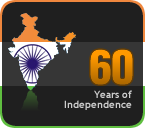I am happy to say that this is one of the prize-winning entries at the
Dove & Yahoo! Real Beauty Contest organised by Indiblogger.
Beauty means a lot things for me — an old woman who has lived for more than eight decades and has seen, admired and enjoyed so much beauty. Beautiful people,beautiful places, beautiful works of art, and most importantly, beautiful works of Mother Nature.
Beauty in anything is pleasant to the eyes, soothing to the mind and sometimes makes one’s head feel intoxicated . Such is the power of beauty, particularly if it is nature at work. A beautiful face untouched by artificial make-up ( which is very rare these days) is really a sight for tired eyes. A freshly-opened flower with dew drops shining on it makes one wonder about the power of nature! Sunrise and sunset with a few clouds here there reflecting the sunlight in various hues make me even at this age want to hold on to that beautiful scene for ever and enjoy it forever -- as Keats said, “a thing of beauty is a joy forever”.
Beauty lies in the eyes of the beholder is another saying! How true!! A person who has no aesthetic sense will not be able to appreciate beauty in any form or in anything. On the other hand anyone who appreciates beauty will find it lurking somewhere, half -hidden half- submerged in everything around us. I feel that such a person is blessed.
A good- looking gentleman (whose wife was just the opposite) was once asked by a cousin of mine as to how he came to marry her and live with her! “Just look at her with my eyes” was his answer!
“Beauty is what beauty does”. I heard this for the first time when I was a young bride of three four months and that too from my husband’s uncle! By some quirk of fate this uncle had to give up his house and had no place to go. So he turned to us and stayed with us for some time. I really liked him and respected him from the moment I saw him. So his staying with us was no big problem for me. In fact I learned a lot from him to my advantage.
Whenever I put a tasty dish on the dining table he used to say “Beauty is what beauty does”. I had never been bracketed with beauty by anybody before and also I had no illusions about myself. But his saying this gave me so much confidence in myself and in my looks.
Mine was an arranged marriage, as was the custom of those days. The girl and the boy were given a chance to see each other and approve of their parents’ selection for the marriage to be finalised . But my husband and myself were given no such choice. We saw each other only after everything was finalised. Because I knew my limitation I used to tease him that he was not given any chance to say NO.
“Beauty is only skin deep” is very much wrong according to me. I put it as beauty is ‘bone deep ’and also “mind deep’. Bone structure plays a great part in making a face as well as the body look beautiful and attractive. I have come across some Adivasi workers in tea gardens in West Bengal whose facial bone structures and the formation of their skull bones make them very attractive; they have features which are much admired and longed for by the modern urban youngsters.
A beautiful face must go with a beautiful mind. If one’s mind is crowded with ugly thoughts these thoughts somehow show on the face and mar ones looks. Likewise, one should not be vain about one’s beautiful looks. This kind of vanity also reflects on one’s face and kills the beauty there. This is neither preaching nor words of wisdom. One gets to know these facts by experience and with age.
Or by reading the story of Snow White and the seven dwarfs.
Dove & Yahoo! Real Beauty Contest organised by Indiblogger.
Beauty means a lot things for me — an old woman who has lived for more than eight decades and has seen, admired and enjoyed so much beauty. Beautiful people,beautiful places, beautiful works of art, and most importantly, beautiful works of Mother Nature.
Beauty in anything is pleasant to the eyes, soothing to the mind and sometimes makes one’s head feel intoxicated . Such is the power of beauty, particularly if it is nature at work. A beautiful face untouched by artificial make-up ( which is very rare these days) is really a sight for tired eyes. A freshly-opened flower with dew drops shining on it makes one wonder about the power of nature! Sunrise and sunset with a few clouds here there reflecting the sunlight in various hues make me even at this age want to hold on to that beautiful scene for ever and enjoy it forever -- as Keats said, “a thing of beauty is a joy forever”.
Beauty lies in the eyes of the beholder is another saying! How true!! A person who has no aesthetic sense will not be able to appreciate beauty in any form or in anything. On the other hand anyone who appreciates beauty will find it lurking somewhere, half -hidden half- submerged in everything around us. I feel that such a person is blessed.
A good- looking gentleman (whose wife was just the opposite) was once asked by a cousin of mine as to how he came to marry her and live with her! “Just look at her with my eyes” was his answer!
“Beauty is what beauty does”. I heard this for the first time when I was a young bride of three four months and that too from my husband’s uncle! By some quirk of fate this uncle had to give up his house and had no place to go. So he turned to us and stayed with us for some time. I really liked him and respected him from the moment I saw him. So his staying with us was no big problem for me. In fact I learned a lot from him to my advantage.
Whenever I put a tasty dish on the dining table he used to say “Beauty is what beauty does”. I had never been bracketed with beauty by anybody before and also I had no illusions about myself. But his saying this gave me so much confidence in myself and in my looks.
Mine was an arranged marriage, as was the custom of those days. The girl and the boy were given a chance to see each other and approve of their parents’ selection for the marriage to be finalised . But my husband and myself were given no such choice. We saw each other only after everything was finalised. Because I knew my limitation I used to tease him that he was not given any chance to say NO.
“Beauty is only skin deep” is very much wrong according to me. I put it as beauty is ‘bone deep ’and also “mind deep’. Bone structure plays a great part in making a face as well as the body look beautiful and attractive. I have come across some Adivasi workers in tea gardens in West Bengal whose facial bone structures and the formation of their skull bones make them very attractive; they have features which are much admired and longed for by the modern urban youngsters.
A beautiful face must go with a beautiful mind. If one’s mind is crowded with ugly thoughts these thoughts somehow show on the face and mar ones looks. Likewise, one should not be vain about one’s beautiful looks. This kind of vanity also reflects on one’s face and kills the beauty there. This is neither preaching nor words of wisdom. One gets to know these facts by experience and with age.
Or by reading the story of Snow White and the seven dwarfs.

















